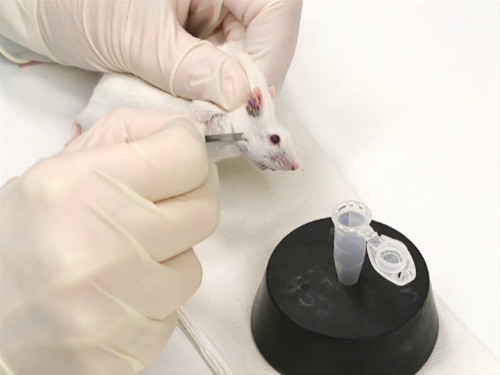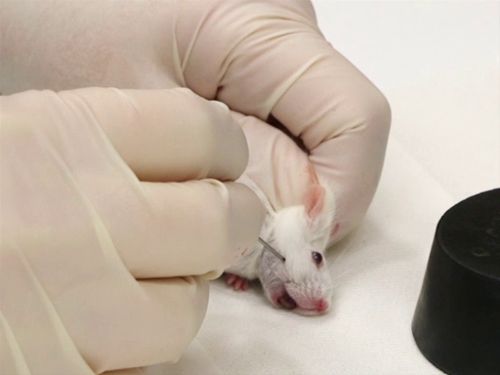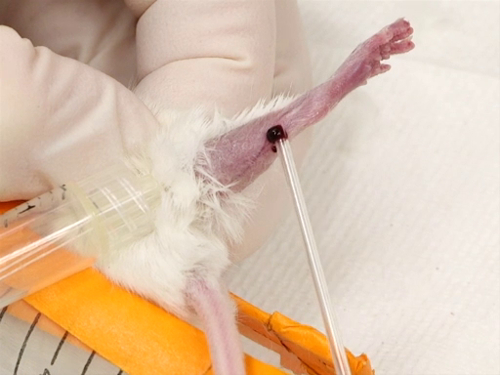血液采集 II
Overview
来源: 凯斯图尔特, RVT, RLATG, CMAR;瓦莱丽. 施罗德, RVT, RLATG。圣母大学
收集的血液从老鼠和老鼠的分析可以通过多种方法进行。每种收集方法在所需的克制类型、程序的侵入性和一般麻醉的必要性方面都有不同。1历史上, 使用的复古眶窦腔已被使用, 但不是没有辩论。由于眼眶出血引起的潜在组织损伤, 甚至失明的争议, 导致了小鼠面部和下颌下腺出血方法的发展。小鼠和大鼠的隐静脉采血是另一种已开发的技术。这些程序不需要麻醉, 因此是适当的, 当使用麻醉剂可能混淆血液结果或其他数据。
Procedure
1. 小鼠面静脉出血
- 设备
- 血液的汇集从一个自由的抓住入血液管或离心管。在某些情况下, 将血液直接收集到红细胞压积管是可取的。
- 黄花针将根据年龄和性别选择合适的动物大小。
- 针根据老鼠的年龄或大小被选择如下:
4mm 柳叶刀: 3-4 周大鼠 (体重低于15克)
5mm 柳叶刀: 雌性小鼠10周以下 (低于20克体重)
5mm 柳叶刀: 雄性小鼠6周以下 (低于20克体重)
5mm 柳叶刀: 用于 single-drop 样品 (血液涂片)
5.5mm 柳叶刀: 雌性小鼠超过10周 (超过 ~ 20 克体重)
5.5mm 柳叶刀: 雄性小鼠超过6周 (超过 ~ 20 克体重)
5.5mm 柳叶刀: 大样本
- 针根据老鼠的年龄或大小被选择如下:
- 克制
- 使用 scruffing 技术抑制小鼠。
- 重要的是要尽量减少头部的侧向运动。这确保了准确和安全的静脉穿刺与柳叶刀。
- 血液撤退
- 上臂柳叶刀与皮肤表
Application and Summary
References
- Fernandez, I., Arantza, P., Del Teso, N., Perez, V. and Rodriguez-Cuesta, J. 2010. Clinical biochemistry parameters in C57BL/6J mice after blood collection from the submandibular vein and retroorbital plexus. Journal of American Association of Laboratory Animal Science. 49:2. 202-210.
- Joslin, O.T. 2009. Blood collection techniques in exotic small animals. Journal of Exotic Pet Medicine. 18:2. 117-139.
- Hem, A., Smith, A.J. and Solberg, P. 1998. Saphenous vein puncture for blood sampling of the mouse, rat, hamster, gerbil, guinea pig, ferret and mink. Laboratory Animals. 32. 364-368.
- Diehl, K-H., Hull, R., Morton, D., Pfister, R. Rabemampianina, Y., Smith, D., Vidal, J-M., and van de Vorstenbosch, C. 2001. A good practical guide to the administration of substances and removal of blood, including routes and volumes. Journal of Applied Toxicology. 21. 15-23.
Tags
跳至...
此集合中的视频:

Now Playing
血液采集 II
Lab Animal Research
73.6K Views

啮齿动物的处理和克制技术
Lab Animal Research
175.1K Views

基本护理程序
Lab Animal Research
28.1K Views

育种和断奶的基本原理
Lab Animal Research
35.8K Views

啮齿动物识别 I
Lab Animal Research
54.9K Views

啮齿动物鉴定 (2)
Lab Animal Research
25.7K Views

药物注射 I
Lab Animal Research
100.9K Views

药物注射 II
Lab Animal Research
35.0K Views

药物注射 III
Lab Animal Research
31.5K Views

药物注射 IV
Lab Animal Research
51.9K Views

血液采集 I
Lab Animal Research
172.2K Views

麻醉诱导与维护
Lab Animal Research
50.8K Views

啮齿动物手术的考虑事项
Lab Animal Research
22.5K Views

诊断尸检和组织采集
Lab Animal Research
58.3K Views

无菌组织采集
Lab Animal Research
34.9K Views
版权所属 © 2025 MyJoVE 公司版权所有,本公司不涉及任何医疗业务和医疗服务。



